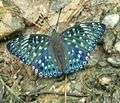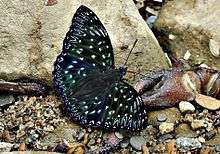Dichorragia nesimachus
Dichorragia nesimachus, the constable, is a species of nymphalid butterfly found in Asia. The genus was earlier considered to belong to the subfamily Cyrestinae and sometimes the Apaturinae, but is now considered as an sister of the genus Stibochiona in the subfamily Pseudergolinae.[1][2] Several geographical forms with variations in colour are noted within the wide distribution range extending from India in the west to Japan in the east. In Vietnam, it is thought to show hill topping behaviour and is typically found in dense forest habitats.[3] They may also be found mud puddling with other species.[4]
 D. n. formosanus
D. n. formosanus


| Constable | |
|---|---|
.jpg) | |
| in Assam | |
 | |
| in Meghalaya | |
| Scientific classification | |
| Kingdom: | |
| Phylum: | |
| Class: | |
| Order: | |
| Family: | |
| Genus: | |
| Species: | D. nesimachus |
| Binomial name | |
| Dichorragia nesimachus (Doyere, 1840) | |
| Synonyms | |
| |
A closely related species Dichorragia ninus is found in New Guinea and surrounding islands although some authors include it as a subspecies of D. nesimachus.[5][6]
Subspecies
- D. n. nesimachus (Sikkim, Bhutan, Assam, Manipur - Indochina, South Yunnan)
- D. n. baliensis Shimagami, 1990 (Bali)
- D. n. deiokes Fruhstorfer, 1913 (southern Thailand, Peninsular Malaya)
- D. n. derdas Fruhstorfer, 1903 (Borneo)
- D. n. formosanus Fruhstorfer, 1909 (Taiwan)
- D. n. harpalycus Fruhstorfer, 1913 (Banggai Islands)
- D. n. machates Fruhstorfer, 1903 (Sumatra, Batu Islands)
- D. n. leytensis Shimagami, 1990 (Philippines: Leyte)
- D. n. luzonensis Shimagami, 1990 (Philippines: Luzon)
- D. n. mannus Fruhstorfer, 1898 (Java)
- D. n. nesiotes Fruhstorfer, 1903 (Japan)
- D. n. nesseus (Grose-Smith, 1893) (western China)
- D. n. niasicus Fruhstorfer, 1909 (Nias)
- D. n. peisandrus Fruhstorfer, 1913 (Sula Islands)
- D. n. peisistratus Fruhstorfer, 1913 (Philippines)
- D. n. pelurius Fruhstorfer, 1897 (Sulawesi)
- D. n. tanahmasa Sato & Hanafusa, 1993 (Batu Islands)
References
- Wahlberg, N.; Brower, A. V. Z. & Nylin, S. (2005). "Phylogenetic relationships and historical biogeography of tribes and genera in the subfamily Nymphalinae (Lepidoptera: Nymphalidae)". Biological Journal of the Linnean Society. 86: 227–251. doi:10.1111/j.1095-8312.2005.00531.x.
- Zhang, Min; Yang Zhong; Tianwen Cao; Yupeng Geng; Yuan Zhang; Ke Jin; Zhumei Ren; Rui Zhang; Yaping Guo; Enbo Ma (2008). "Phylogenetic relationship and morphological evolution in the subfamily Limenitidinae (Lepidoptera: Nymphalidae)" (PDF). Progress in Natural Science. 18: 1357–1364. doi:10.1016/j.pnsc.2008.03.025.
- Spitzer, K; V Novotny; M Tonner & Jan Leps (1993). "Habitat preferences, distribution and seasonality of the butterflies (Lepidoptera, Papilionoidea) in a montane tropical rain forest, Vietnam" (PDF). Journal of Biogeography. 20: 109–121. doi:10.2307/2845744.
- Kubo, Kaiya (1960). "Butterfly hunting in the mountains of central Japan" (PDF). Journal of the Lepidopterists' Society. 14 (3): 203–207.
- Corbet AS, Pendlebury HM, Eliot JN (1992). The butterflies of the Malay Peninsula. Malayan Nature Society, Kuala Lumpur.
- Parsons M. (1999). The butterflies of Papua New Guinea: their systematics and biology. Academic Press, San Diego.